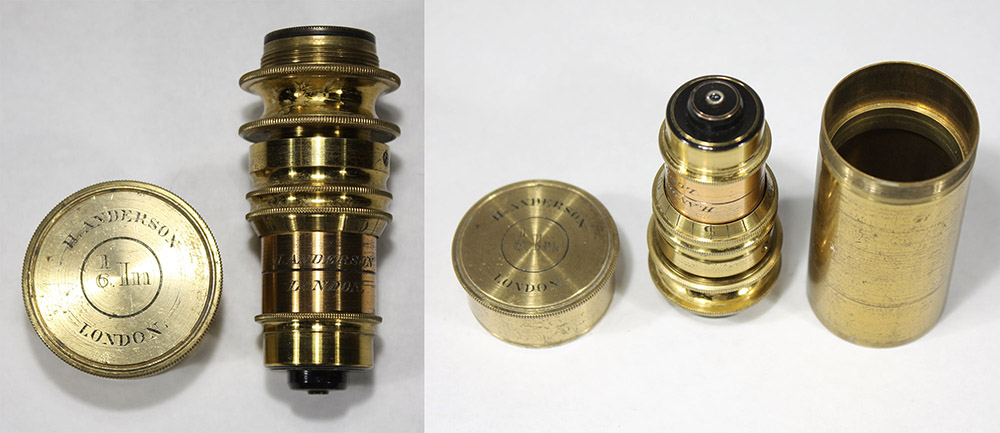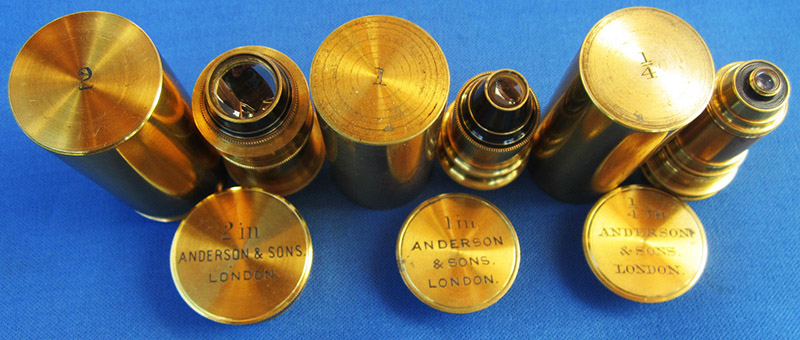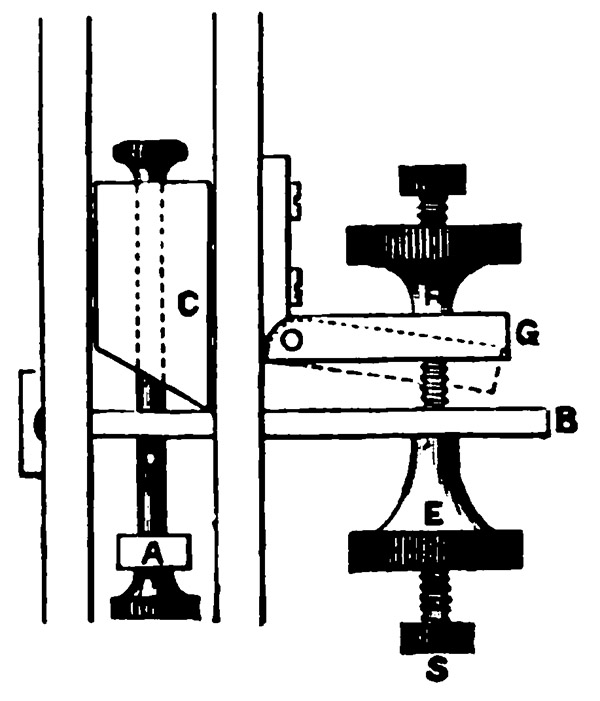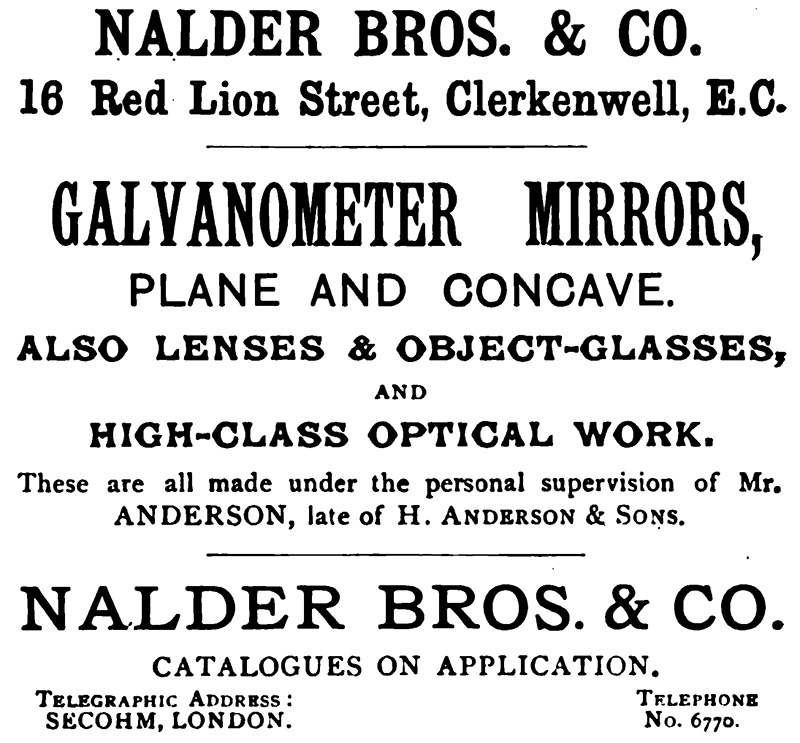
Figure 1. Early 1860s “Ross”-pattern bar-limb microscope, manufactured by Henry Anderson.
Henry Anderson, ca. 1817 - 1904
Henry James Anderson, 1846 - 1910
William Alfred Anderson, 1848 - ca. 1920
H. Anderson
Anderson and Sons
by Brian Stevenson
last updated September, 2019
Henry Anderson worked for microscope-maker Andrew Ross (1798-1859) from his youth until the latter man’s death. A contemporary microscope expert, George W. Royston-Pigott (1819-1889), described Anderson as “educated by the late Andrew Ross from a boy, and brought up under his thumb”. In his time, Ross was one of the finest manufacturers of microscopes and optics in the world. Among his many achievements was development of a bar-limb microscope pattern that became known by his name. Royston-Pigott further described Henry Anderson as “an experienced working optician, who has for years made Ross's form, and excepting Ross himself, is the best maker of that form of microscope”.
During the early-to-mid 1860s, Anderson began his own business. Not surprisingly, he continued to manufacture the same patterns of instruments that he had made for Ross (Figure 1). Considering his history, it is likely that a substantial proportion of microscopes, lenses, and other apparatus signed “Andrew Ross” were made by Henry Anderson during his time with Ross.

Figure 1.
Early 1860s “Ross”-pattern bar-limb microscope, manufactured by Henry Anderson.

Figure 2.
A 2-inch objective lens, signed “Anderson from A. Ross's London”, dating from the intial years of Henry Anderson's business, ca. 1865. Adapted with permission from https://www.microscope-antiques.com/rossbarlimb.html.

Figure 3.
A Henry Anderson 1/6 inch objective lens with correction capabilities, circa 1865.

Figure 4.
Three ca. 1885 objective lenses by Anderson and Sons. Adapted for nonprofit, educational purposes from an internet sale site.

Figure 5.
A 1900 engraving and a recent photograph of a “portable field microscope”. In 1900, “The Journal of the Royal Microscopical Society” reported the display of such an instrument, noting that it was, “first made some twenty-five years ago (i.e. ca. 1875), by Mr. Henry Anderson, who was for many years with the late Mr. Andrew Ross”. It was also noted that, “this Microscope has been in Messrs. Newton's catalogue for many years, they having kindly lent us this illustration”.
According to information that he provided to census-takers, Henry Anderson was born in Paddington, London, in about 1817. His marriage record noted that Anderson’s father was a “wine merchant” named John Anderson.
Anderson is first recognizable in records of the 1841 census, where he was an “optician”, boarding with a family at 27 Clerkenwell Close. He would then have been 23-24 years old, old enough to have completed his apprenticeship. Those records have not been located, but, considering Royston-Pigott’s comment about Anderson having been educated by Ross “from a boy”, it is reasonable to assume that Ross was his Master. Ross’s initial shop was on St. John’s Square, Clerkenwell, a 5-6 minute walk from Anderson’s 1841 home.
Henry married Ann Margaret Ledieu on December 11, 1845. The couple had two children, Henry James (born 1846) and William Alfred (born 1848). In time, both sons would work as opticians with their father.
After Andrew Ross died in 1859, the microscope aspects of the firm were continued by his son, Thomas (1823-1870). Ross’s son-in-law, John Dallmeyer (1830-1883), inherited the photographic arm of the Ross business. Both Ross and Dallmeyer produced microscopes and photographic equipment, however, competing directly with each other.
Anderson did not display anything at the large 1862 London International Exhibition, suggesting that he was not working independently at that time. The 1861 census recorded that the two sons, aged 13 and 14, were “scholars”, meaning that they were attending school and were not apprentices. Life was fairly good for the Andersons in 1861 - they employed a 16 year-old girl as a domestic servant.
However, a mid-1860s list of London microscope makers included “H. Anderson, 10 Belitha Terrace, Barnsbury Park, Islington” (B. Sobel, personal communication), which was the Anderson home on the 1851 and 1861 censuses. A reasonable guess is that Anderson remained with Ross until the boys were old enough, and competent enough, to help their father with an independent optical business.
By the time of the 1871 census, the Andersons were living in Alma Grove, near Broughton Street, Islington. This was the site of the Anderson optical shop through 1891. The 1871 census listed son Henry James as a “optician’s shopman”, and William Alfred as an “optician”. The family no longer employed a servant.
Microscopes and lenses are known with signatures “H. Anderson”, “Anderson”, and “Anderson and Sons”. The firm became “H. Anderson and Sons” by 1884, at the latest, and that name was retained through 1891. The timelines of each iteration are not certain, but it is reasonable to guess that “H. Anderson” and “Anderson” preceded “Anderson and Sons”.
The 1873 marriage of Henry James and the 1875 marriage of William both gave the men’s occupations as “optician”.
William as a “working optician” in the 1881 census. Henry James Anderson, however, had take a job as a clerk at an ink factory. Luring him home may have led to the partnership of Henry and his sons, as Henry James is afterward recorded as an optician and, later, owner of H. Anderson and Sons.
William’s involvement with the business did not last long. The 1883 christening record of his daughter, Winifred, listed his occupation as “artist”. All subsequent records refer to him as an artist and painter.
An 1884 report from D. Honeyman to the Nova Scotian Institute of Natural Science (Canada) stated, “I have had sections of the preceding rocks carefully prepared by Dr. Alexis S. Julien, New York. Four of them have already been imperfectly examined by an inferior polariscope. I have re-examined these thoroughly by the splendid new polariscope-microscope made by Anderson & Sons, London”. This sets the latest possible date for the formation of the father-son partnership.
The Andersons developed a new type of fine focus for their microscopes, described in 1888 in The Journal of the Royal Microscopical Society as “Anderson's Double-action Fine Adjustment - Messrs. Anderson & Sons have devised a fine adjustment by which two different rates of speed in focusing are provided, the one acting on the lever at the rate of 40 turns to the inch, and the other at 100 to the inch” (Figure 3). Essentially, this was a pair of fine-focus mechanisms, which permitted two different rates of focusing. Notably, this fine focus operated directly on the body tube, a style that was already falling out of favor.
The 1891 census implies that son Henry James Anderson was then in charge of the business. He was listed as an “optician” and “employer”, whereas father Henry was an “optician” but “neither employer nor employee”.
By this time, English patterns such as the Ross bar-limb were largely out of fashion in Britain and elsewhere, having been replaced by the “Continental” styles of Zeiss, Leitz, and others.
In June, 1891, “Anderson H. & H.J., Alma-grove, Copenhagen-street,. manufacturing opticians”, began the process of bankruptcy. This was finished in March, 1892. The assets were purchased by James J. Hicks (1837-1916), a manufacturer of precise clinical thermometers.
Nalder Brothers and Company, manufacturers of electrical and optical goods, announced in 1893 that their optical apparatus were “made under the personal supervision of Mr. Anderson, late of H. Anderson & Sons”. This was probably the son, Henry James, since the father was then in his late 70s.
The 1901 census recorded that Henry Anderson, then 86 years old, was a “retired optician”, living in Binstead, Hampshire with his wife and a servant. Younger son William lived down the road, with his wife, daughter, and servant. Henry James Anderson was listed as a “commercial traveller”, that is, a traveling salesman. His second son, Francis, who had been an “optician’s apprentice” in 1891, was now an “artist”. Henry J. Anderson’s other three sons all worked as clerks.
Henry Anderson died in 1904, in Binstead, Hampshire. Son Henry James Anderson died in 1910. The younger son, William Alfred, was still alive in 1911, and the date of his death is not yet known.

Figure 6.
A diagram of Anderson and Sons’ 1888 “Double-action fine adjustment”. It was described in “The Journal of the Royal Microscopical Society” as “Messrs. Anderson & Sons have devised a fine adjustment by which two different rates of speed in focusing are provided, the one acting on the lever at the rate of 40 turns to the inch, and the other at 100 to the inch. The mechanism is shown in fig. 62, where A is a stud carrying the usual tube nose-piece as applied to the ‘Jackson’ form of fine adjustment, with a swinging pin D passing loosely through, and suspended on the top of the metal block C, which slides freely in parallel fittings and terminates below in a knife-edge. B is a long lever acting on C. S is a screw having 40 threads to the inch at the lower part and 100 above; it is fixed in a hinged shoe-piece G, which covers a rigid bar projecting from the side of the body-tube support. In action the rotation of the milled head E upwards raises the lever B, and consequently C, D, and A (the latter carrying the tube nose-piece), at the rate of 40 turns to the inch, and when a slower motion is required, the rotation downwards of the milled head F draws up the screw and shoe-piece G together with E, B, C, D, and A, at the rate of 100 turns to the inch, the rigid piece within G serving as the stop for this motion. A spiral spring within the body-tube acts against the upward movement of the lever B, and therefore opposes the screw movements of the milled heads E and F”.

Figure 7.
A December, 1893, advertisement from Nalder Brothers & Company, announcing that their optical lenses were “made under the personal supervision of Mr. Anderson, late of H. Anderson & Sons”. Presumably, this employee was Henry James Anderson.
A final note: a Ross-pattern microscope signed “Anderson London” was recent auctioned with an attribution to a London maker of scales named James Andrew Anderson. That man ended work around 1850, and, considering his known output, there are no particular reasons to attribute Ross-style microscopes to him.
Resources
Christening record of Henry James Anderson (1846) Parish records of St. Clement City Road, accessed through ancestry.com
Christening record of Winifred Anderson (1883) Parish records of St Luke Holloway, accessed through ancestry.com
Christening record of William Alfred Anderson (1848) Parish records of St. Clement City Road, accessed through ancestry.com
Clifton, Gloria (1995) Anderson, James Andrew, Directory of British Scientific Instrument Makers 1550-1851, Zwemmer, London, page 8
Clifton, Gloria (1995) Ross, Andrew, Directory of British Scientific Instrument Makers 1550-1851, Zwemmer, London, page 238
The Commercial Gazette (1891) Bankruptcy proceedings, “Anderson H. & H. J., Alma-grove, Copenhagen-street, manufacturing opticians”, June 3, page 4
The Electrical Journal (1893) Advertisements from Nalder Brothers & Co., Vol. 32
England census and other record, accessed through ancestry.com
Honeyman, D. (1884) Notes of a polariscopic and microscopic examination of crystalline rocks of Nova Scotia and Cape Breton, Proceedings and Transactions of the Nova Scotian Institute of Natural Science, Vol. 6, page 122
Journal of the Royal Microscopical Society (1888) Anderson's double-action fine adjustment, pages 325 and 375
Journal of the Royal Microscopical Society (1900) Portable field microscope, page 329
Kelly’s Directory of the Watch and Clock Trades (1880) “Anderson Henry, Alma grove, Copenhagen st. N”, page 54
Kelly's Post Office London Directory (1891) “Anderson Henry, optician, Alma grove, Copenhagen street N”, page 748
���������������������������������������������������London Gazette (1891) Adjudications: “Anderson, H.J., 8, Corbyn-street, Upper Holloway, lately carrying on business at Alma-grove, Copenhagen-street, London Member of the firm of H. Anderson and Sons”, March 18, page 1679
London Gazette (1892) Notices of Release of Trustees: “8, Corbyn-street, Upper Holloway, lately carrying on business at Alma-grove, Copenhagen-street, London. Member of the Firm of H. Anderson and Sons”, March 18, page 1679
London Poll Book (1878) “Parish of St Mary Islington, Ward 5, Barnsbury … Anderson, Henry, Alma Grove”, accessed though ancestry.com
Marriage record of Henry Anderson and Ann Margaret Ledieu (1845) Parish records of St. Mark Islington, accessed through ancestry.com
Marriage record of Henry James Anderson and Emma Rosa Slade (1873) Parish records of St. Andrew Barnsbury, accessed through ancestry.com
Marriage record of William Alfred Anderson and Ann Smith Hughson (1875) Parish records of St. Mary Islington, accessed through ancestry.com
McConnell, Anita (1998) The Life and Times of J.J. Hicks (1837-1916): “King of the Clinicals”, William Sessions Limited, pages 6, 16, and 109
Nature (1893) Advertisements from Nalder Brothers & Co.
Royston-Pigott, George W. (1873) The high-power definition microscopes, English Mechanics and the World of Science, Vol. 17, pages 648-649
Turner, Gerard l’E. (1989) The Great Age of the Microscope, Adam Hilger, Bristol, page 300, item 357